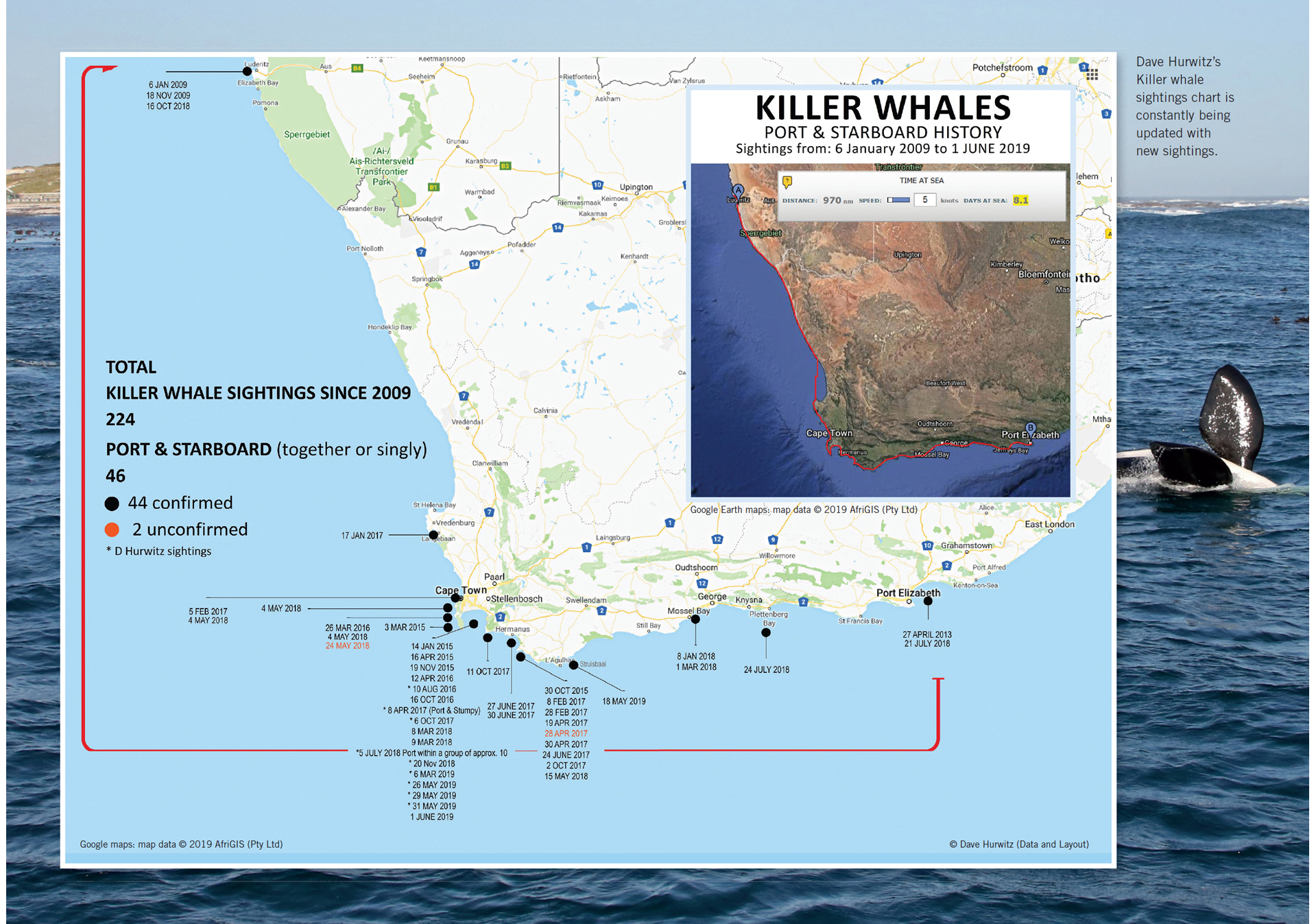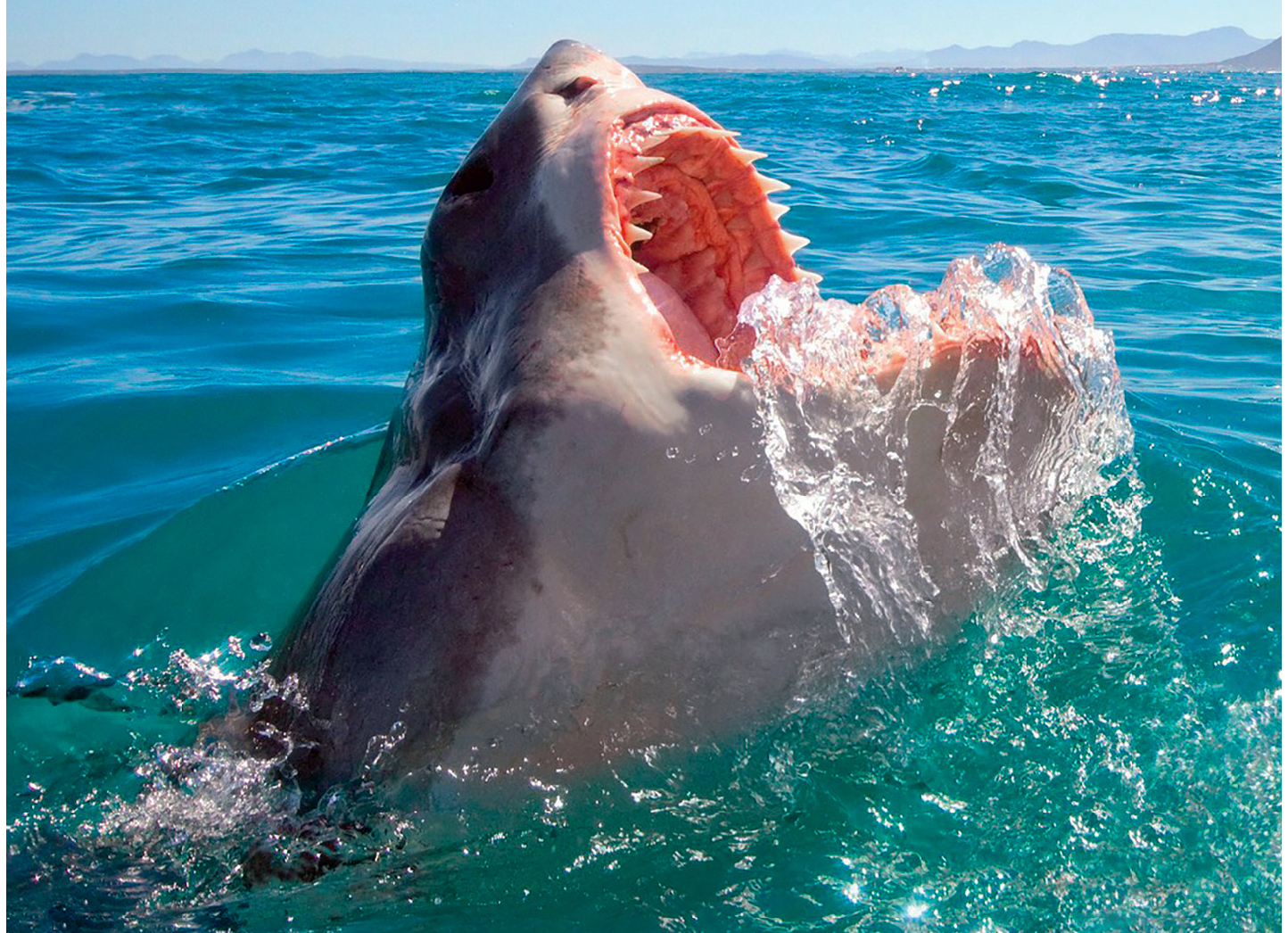![]()
Recent times had been hard on the cage-diving industry, but as more became known about the Orca-vs-Great White saga, nuances crept in. Was it ‘all or nothing’, or was there some wiggle room in which businesses could operate? Could other areas along the coast be explored, and other aspects of life at Africa’s southernmost tip be developed for tourism? Adaptation would define the way forward.

The famous flying sharks – in some areas, Great Whites often leap clear of the water (known as breaching) when hunting seals.
Chris Fallows
In November 2018 Dave Caravias commented: ‘There were times this year when it felt as if we were being hit on all sides. Our sharks were not as reliable as they had been in the past, and visitors knew this, so numbers were often affected. In the beginning of the year the news went all over the world that Cape Town was about to run out of water, and then from March onwards violent demonstrations and riots started happening in the area. Who wants to come on holiday to a place where they might see no sharks, can’t have a shower, and might get caught in a riot!?’ His points were undeniably valid: Gansbaai’s new world had its ups and downs. But for many in the shark industry there now seemed to be more downs than ups.
The dips in the fortunes of cage-diving operators had produced casualties all across Shark Town’s ecotourism-reliant businesses. Frank Rutzen’s employers, Supreme Sharks, had been forced to close. Among other losers were a cleaning firm and the Kleinbaai harbour clothing shop. Several staff members working in the industry had to be laid off. Many of the businesses that survived did so through a mix of shedding staff, temporary closures, and cutting costs wherever possible.
![]()
A chart (see pages 110–111) compiled by Simon’s Town-based naturalist Dave Hurwitz shows the confirmed sightings of Port and Starboard. During 2018 the chart shows the presence of the two Killer whales along South Africa’s south coast from Cape Town to Mossel Bay. The chart lists only confirmed sightings, and so is by no means a complete map of their movements. Additionally, although the distinctive collapsed dorsal fins of both whales made them easy to identify, it also made them less visible, which must certainly have impacted the number of sightings on the chart. Recorded sightings indicate that the Orcas travel huge distances and sometimes at very fast speeds.
The chart of 2018 starts with a sighting of the Orcas in January in Mossel Bay; in March they were again in Mossel Bay and also False Bay; in May, off Gansbaai and off Cape Town; then in July there are entries for sightings off Plettenberg Bay and Port Elizabeth. By October they were in Namibia off Lüderitz, which, as far as current reports indicate, is the northern limit of their range.

Dave Hurwitz’s Killer whale sightings chart is constantly being updated with new sightings.
Wilfred Chivell
The sightings chart broadly coincides with the appearance and disappearance of Great Whites off Gansbaai. No carcasses were washed up in 2018, which might indicate that the sharks were by then fully aware of the threat from Orcas, and were acting accordingly, somehow managing to evade the recently arrived, superior apex predators. The last entry on Hurwitz’s chart, for 1st June 2019, is when, for the first time, the Orcas were seen predating on Cow sharks around Seal Island in False Bay.
![]()
In February 2017, at a time when Great Whites were completely absent from the usual chumming sites near Dyer Island, Dave Caravias had been out on a fatbike trip with clients near Die Plaat on the De Kelders (the northern) side of Walker Bay. He was coming down the 4×4 track near De Kelders when he saw a large shark close in to the beach. He messaged Alison Towner, who that day happened to be diving to check out various receivers she had placed on the seabed to track shark movements. Dave knew Alison was diving, and knew that she would be in the water very close to where he was watching the Great White shark. Alison got the message and aborted her dive. Dave and his group continued their ride, and from cliff tops they saw another two Great Whites swimming close in near the rocks.
Then, in 2018, a local luxury hotel called Grootbos started operating flights for guests around the picturesque coastline of Walker Bay. By this time Dave was often being hired by Grootbos to take their guests out on fatbike trips, and he got used to hearing reports from visitors of Great Whites seen from the air off De Kelders and outside the surf along the beach towards Hermanus. What Dave found curious was that sharks were being seen in many places other than around Dyer Island, where the cage-diving boats worked.
He wondered whether this indicated specific areas that the sharks avoided – or where they sought refuge – when the Orcas were around. Did the Orcas have preferred killing areas, or had the predations taken place around Dyer Island because that is where the most sharks are for most of the time?
Whatever the case, these sightings might mean that not all sharks flee far – some may move just out of the historic danger zone. The shark-diving operators have licences to chum for sharks in specific areas around Dyer Island and near the adjacent beach. If Dave’s killing-zone theory proved correct, then drones could be used to search for sharks when they were absent from their usual areas. Although parts of Walker Bay are protected for the benefit of whales and other marine life (so even if sharks were known to be in these areas, it would not be possible for operators to go and look for them), were sharks discovered to be in other, unprotected areas, then operators could apply for variations to their permits. This could be one of the ways in which Shark Town’s ecotourism would need to change in order to survive.

Dave’s fatbike trips proved to be a great success.
Dave Caravias
![]()
The Orca predations of the last two years now form part of Shark Town’s global reputation. Chivell, McFarlane, Caravias and others are constantly on the lookout for new strings to their bows, knowing that the almost guaranteed daily Great White bonanza is over.

Cage-diving businesses will have to diversify, and maybe Great Whites will become just one of many attractions.
Dave Caravias

Bronze Whalers, the support act, often take star billing.
Kelly Baker
Five years ago, the idea of cage diving with Bronze Whalers would have been met with scepticism; now it is a reality for which everyone is grateful. Entrepreneurs are constantly on the lookout for new opportunities.
It probably won’t be long before the Port and Starboard story itself is turned into a tourist attraction by some enterprising local business person. A shark museum, or an interactive shark centre, could take visitors on a journey through the history of Gansbaai’s involvement with Great Whites. Starting with the liver-oil factory, going on to artisanal shark fisheries, through the development of cage diving, and finishing with the drama of the Orca predations threatening jobs and livelihoods, such a centre could quickly become a major local attraction.
The presence of Great Whites may now be uncertain, but what is certain is that Shark Town’s human inhabitants are adapting to the new reality and will adapt further. Shark Town is situated in an area of outstanding natural beauty, and the waters off the coast are home to a wonderful abundance of marine species. The future may well see Great White sharks becoming just one of a bigger and better, wider and even more exhilarating range of attractions.